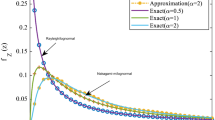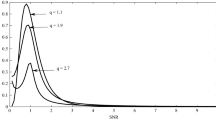Abstract
The η–µ fading distribution is used for better representation of small scale variations of the faded signal in Non Line-Of-Sight conditions. In this paper, first-order Finite-State Markov Chain (FSMC) model of η–µ fading channel is proposed for two cases. i.e., considering received signal amplitude only and by jointly varying amplitude and phase. FSMC model captures the essence of slowly fading channels and acts as an important tool to study the performance of wireless communication systems. The Performance parameters of η–µ fading channels like level crossing rate, steady-state probability, state-time duration and state transition probability are studied. Numerical results depicting the performance of FSMC for η–µ fading channels show that η–µ distribution (Format 2) is a severely affected fading channel as compared to η–µ distribution (Format 1) as the former generally occurs in urban areas whereas the latter occurs in suburban and rural areas.








Similar content being viewed by others
References
Braun, R., & Dersch, U. (1991). A physical mobile radio channel model. IEEE Transactions on Vehicular Technology,40(2), 472–482.
Suzuki, H. (1977). A statistical model for urban radio propagation. IEEE Transactions on Communications,25(7), 673–679.
Yacoub, M. D. (2000). The η–µ distribution: A general fading distribution. In IEEE fall vehicular technology conference, Boston, USA (pp. 872–877).
Yacoub, M. D. (2007). The k-µ distribution and the η − µ distribution. IEEE Antennas and Propagation Magazine,49(1), 68–81.
Filho, J. C. S., & Yacoub, M. D. (2005). Highly accurate η − µ approximation to the sum of M independent non-identical Hoyt variates. IEEE Antennas and Wireless Propagation Letters,4(1), 436–438.
Da Costa, D. B., & Yacoub, M. D. (2007). The η–µ joint phase-envelope distribution. In Wireless communications and networking conference, Kowloon (pp. 1906–1908).
Ermolova, N. Y. (2009). Useful integrals for performance evaluation of communication systems in generalized k-mu and eta-mu fading channels. IET Communications,3(2), 303–308.
Zhang, J., Matthaiou, M., Tan, Z., & Wang, H. (2012). Performance Analysis of digital communication systems over composite eta-mu/Gamma fading channels. IEEE Transactions on Vehicular Technology,61(7), 3114–3124.
Sadeghi, P., Kennedy, R. A., Rapajic, P. B., & Shams, R. (2008). Finite-State Markov modelling of fading channels. IEEE Signal Processing Magazine,25(5), 57–80.
Guan, Y. L., & Turner, L. F. (1999). Generalised FSMC model for radio channels with correlated fading. IEE Proceedings on Communications,146(2), 133–137.
Riediger, M., & Shwedyk, E., (2003). Communication receivers based on Markov models of the fading channel. In IEEE Canadian conference on electrical and computer engineering, Winnipeg, MB, Canada (pp. 275–279).
Wang, H. S., & Moayeri, N. (1995). Finite-state Markov channel—A useful model for radio communication channels. IEEE Transactions on Vehicular Technology,44(1), 163–171.
Park, J. M., & Hwang, G. U. (2009). Mathematical modelling of Rayleigh fading channels based on finite state Markov Chain. IEEE Communications Letters,13(10), 763–766.
Nithya, V., & Bhaskar, V. (2011). Finite-state Markov channel modelling under jointly varying amplitude and phase in time-varying flat fading channels. IET Communications,5(9), 1237–1245.
Bhaskar, V., & Peram, N. (2013). Performance modelling of finite state Markov chains for Nakagami-q and α-µ distributions over adaptive modulation and coding schemes. International Journal of Electronics and Communications,67(1), 64–71.
Bhaskar, V. (2007). Finite-state Markov model for Lognormal, Chi square(central), Chi square(non-central) and K distribution. International Journal of Wireless Information Networks,14(4), 237–250.
Bhaskar, V., & Adjallah, K. H. (2005). Finite-State Markov Model for Chi square(central) SNR distribution in A-CDMA systems. In International conference on communications, internet and information technology, Cambridge, MA.
Jakes, W. C. (1974). Microwave mobile communications (1st ed.). New York: Wiley.
http://en.wikipedia.org/wiki/Bessel_function#Modified_Bessel_functions_:_I.CE.B1.2C_K.CE.B1.
Gradshteyn, I. S., & Ryzhik, I. M. (1994). Table of integrals, series and products (5th ed.). San Diego, CA: Academic Press.
Author information
Authors and Affiliations
Corresponding author
Additional information
Publisher's Note
Springer Nature remains neutral with regard to jurisdictional claims in published maps and institutional affiliations.
Appendix
Appendix
1.1 Algorithm to Find Level Crossing Rate (LCR), Steady State Probability (SSP), State Transition Probability (STP), and State Time Duration (STD)
Input: fm, µ and η
Output: LCR, SSP, STP, STD
1.2 η–µ Fading Distribution Format 1
Case 1: First order FSMC modeling of η–µ fading distribution (Format 1) considering the received signal amplitude only
01: Divide the signal amplitude values into K states
02: Set upper limit value for each state \(v_{k}\)
03: Total number of states S = K
04: k = State index
05: for k = 1: S do
06: Calculate LCR, Nk using Eq. (9)
07: Calculate SSP, πk using Eq. (4)
08: Calculate STP, \(t_{k,k - 1}\) for transition from present state to previous state using Eq. (12)
09: Calculate STP, \(t_{k,k}\) for looping back to same state using Eq. (12)
10: Calculate STP, \(t_{k,k + 1}\) for transition from present state to next state using Eq. (12)
11: Calculate STD, \(\overline{\tau }_{k}\) using Eq. (14)
12: end
13: Plot LCR, SSP, STP and STD
Case 2: First order FSMC modeling of η–µ fading distribution (Format 1) by jointly varying both received signal amplitude and phase
13: Divide the phase values into K1 states
14: Set upper limit for each phase state \(v_{k1}\)
15: Total number of states S = K. K1
1.3 η–µ Fading Distribution Format 2
Case 1: First order FSMC modeling of η–µ fading distribution (Format 2) considering the received signal amplitude only
Case 2: First order FSMC modeling of η–µ fading distribution (Format 2) by jointly varying both received signal amplitude and phase
Rights and permissions
About this article
Cite this article
Nithya, V., Priyanka, C. & Bhaskar, V. Joint Phase and Amplitude Modelling Using a Finite-State Markov Chain for η–µ Fading Channels. Wireless Pers Commun 112, 923–940 (2020). https://doi.org/10.1007/s11277-020-07083-x
Published:
Issue Date:
DOI: https://doi.org/10.1007/s11277-020-07083-x




